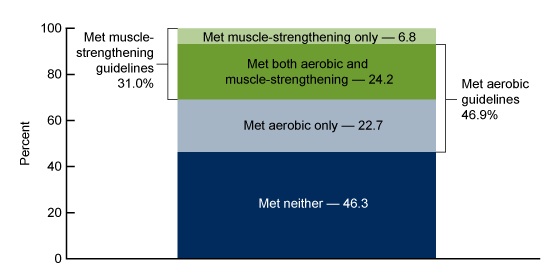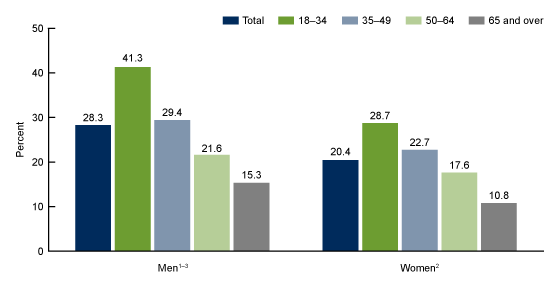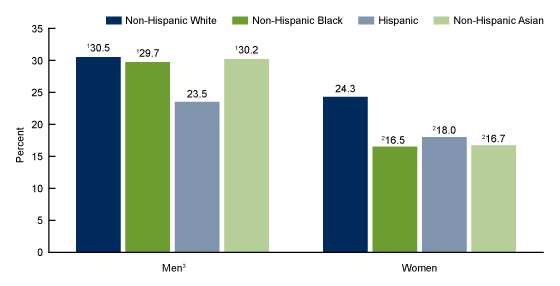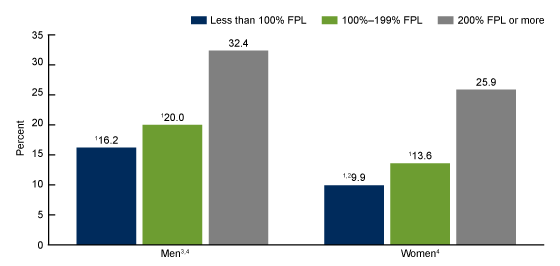Physical Activity Among Adults Aged 18 and Over: United States, 2020
NCHS Data Brief No. 443, August 2022
PDF Version (464 KB)
Nazik Elgaddal, M.S., Ellen A. Kramarow, Ph.D., and Cynthia Reuben, M.A.
- Key findings
- In 2020, about one-quarter of adults aged 18 and over met the physical activity guidelines for both aerobic and muscle-strengthening activities.
- The percentages of both men and women who met the guidelines for both aerobic and muscle-strengthening activities decreased with age.
- The percentage of adults who met the guidelines for both aerobic and muscle-strengthening activities varied by race and Hispanic origin.
- The percentage of adults who met guidelines for both aerobic and muscle-strengthening activities increased as family income increased.
Data from the National Health Interview Survey
- In 2020, 24.2% of adults aged 18 and over met the 2018 Physical Activity Guidelines for Americans for both aerobic and muscle-strengthening activities.
- The percentage of adults who met both physical activity guidelines was higher among men (28.3%) than women (20.4%) and decreased with age for both men and women.
- Among men, Hispanic men were least likely to meet both guidelines, while among women, non-Hispanic White women were most likely to meet both guidelines.
- Adults with family income of 200% of the federal poverty level (FPL) or more were more likely to meet both physical activity guidelines than those with family income of less than 200% of FPL.
Regular physical activity can improve overall health and prevent negative health outcomes in people of all ages (1). Increasing the proportion of adults meeting the 2018 Physical Activity Guidelines for Americans for both aerobic and muscle-strengthening activities is a Healthy People 2030 Leading Health Indicator (2), highlighting its priority for well-being. Research shows that health benefits occur with at least 150 minutes a week of moderate-intensity aerobic activity, and that both aerobic and muscle-strengthening activities are beneficial (1). Using data from the 2020 National Health Interview Survey (NHIS), this report presents estimates of the percentage of men and women aged 18 and over meeting guidelines for both aerobic and muscle-strengthening activities, by age, race and Hispanic origin, and family income.
Keywords: exercise, aerobic, muscle-strengthening, race and Hispanic origin, National Health Interview Survey (NHIS)
In 2020, about one-quarter of adults aged 18 and over met the physical activity guidelines for both aerobic and muscle-strengthening activities.
- Among all adults aged 18 and over, 24.2% met the guidelines for both aerobic and muscle-strengthening activities, 22.7% met only the guidelines for aerobic activity, 6.8% met only the guidelines for muscle-strengthening activity, and 46.3% did not meet the guidelines for either type of activity (Figure 1).
- Among all adults, 46.9% met the guidelines for aerobic activity, with or without meeting the muscle-strengthening activity guidelines.
- Of total adults, 31.0% met the guidelines for muscle-strengthening activity, with or without meeting the aerobic activity guidelines.
Figure 1. Percent distribution of adults aged 18 and over who met 2018 Physical Activity Guidelines for Americans for aerobic and muscle-strengthening activities: United States, 2020

NOTES: Adults met 2018 federal physical activity guidelines if they met both aerobic and muscle-strengthening guidelines outlined in U.S. Department of Health and Human Services 2018 Physical Activity Guidelines for Americans, 2nd edition. Aerobic guidelines for adults recommend at least 150 to 300 minutes a week of moderate-intensity, or 75 to 150 minutes a week of vigorous-intensity, or an equivalent combination of moderate- and vigorous-intensity aerobic activity. Muscle-strengthening guidelines for adults recommend activities of moderate or greater intensity involving all major muscle groups on 2 days a week or more. Estimates are based on household interviews of a sample of the U.S. civilian noninstitutionalized population. Access data table for Figure 1.
SOURCE: National Center for Health Statistics, National Health Interview Survey, 2020.
The percentages of both men and women who met the guidelines for both aerobic and muscle-strengthening activities decreased with age.
- In 2020, 28.3% of men and 20.4% of women met the guidelines for both aerobic and muscle-strengthening activities (Figure 2).
- The percentage of men who met both physical activity guidelines decreased with age, from 41.3% of those aged 18–34, to 29.4% of those aged 35–49, to 21.6% of those aged 50–64, and 15.3% of those aged 65 and over.
- The percentage of women who met the guidelines for both physical activities decreased with age, from 28.7% of those aged 18–34, to 22.7% of those aged 35–49, to 17.6% of those aged 50–64, and 10.8% of those aged 65 and over.
- Men were more likely than women to meet both physical activity guidelines across all age groups.
Figure 2. Percentage of adults aged 18 and over who met 2018 Physical Activity Guidelines for Americans for aerobic and muscle-strengthening activities, by sex and age: United States, 2020

1Significantly different from women for all age groups (p < 0.05).
2Significant linear trend with age (p < 0.05).
3Significant quadratic trend by age (p < 0.05).
NOTES: Adults met 2018 federal physical activity guidelines if they met both aerobic and muscle-strengthening guidelines outlined in U.S. Department of Health and Human Services 2018 Physical Activity Guidelines for Americans, 2nd edition. Aerobic guidelines for adults recommend at least 150 to 300 minutes a week of moderate-intensity, or 75 to 150 minutes a week of vigorous-intensity, or an equivalent combination of moderate- and vigorous-intensity aerobic activity. Muscle-strengthening guidelines for adults recommend activities of moderate or greater intensity involving all major muscle groups on 2 days a week or more. Estimates are based on household interviews of a sample of the U.S. civilian noninstitutionalized population. Access data table for Figure 2.
SOURCE: National Center for Health Statistics, National Health Interview Survey, 2020.
The percentage of adults who met the guidelines for both aerobic and muscle-strengthening activities varied by race and Hispanic origin.
- Hispanic men (23.5%) were less likely to meet both physical activity guidelines than non-Hispanic White (30.5%), non-Hispanic Asian (30.2%), and non-Hispanic Black (29.7%) men (Figure 3).
- Non-Hispanic White women (24.3%) were more likely to meet both guidelines than Hispanic (18.0%), non-Hispanic Asian (16.7%), and non-Hispanic Black (16.5%) women.
- Across all race and Hispanic-origin groups, men were more likely than women to meet the guidelines for both aerobic and muscle-strengthening activities.
Figure 3. Age-adjusted percentage of adults aged 18 and over who met 2018 Physical Activity Guidelines for Americans for aerobic and muscle-strengthening activities, by sex and race and Hispanic origin: United States, 2020

1Significantly different from Hispanic men (p < 0.05).
2Significantly different from non-Hispanic White women (p < 0.05).
3Significantly different from women for all race and Hispanic-origin categories (p < 0.05).
NOTES: Adults met 2018 federal physical activity guidelines if they met both aerobic and muscle-strengthening guidelines outlined in U.S. Department of Health and Human Services 2018 Physical Activity Guidelines for Americans, 2nd edition. Aerobic guidelines for adults recommend at least 150 to 300 minutes a week of moderate-intensity, or 75 to 150 minutes a week of vigorous-intensity, or an equivalent combination of moderate- and vigorous-intensity aerobic activity. Muscle-strengthening guidelines for adults recommend activities of moderate or greater intensity involving all major muscle groups on 2 days a week or more. Estimates are based on household interviews of a sample of the U.S. civilian noninstitutionalized population. Access data table for Figure 3.
SOURCE: National Center for Health Statistics, National Health Interview Survey, 2020.
The percentage of adults who met guidelines for both aerobic and muscle-strengthening activities increased as family income increased.
- The percentage of men who met both physical activity guidelines increased as family income increased, from 16.2% of men with family income less than 100% of the federal poverty level (FPL), to 20.0% of men with income at 100%–199% of FPL, and 32.4% of those with income at 200% of FPL or more (Figure 4).
- The percentage of women who met both physical activity guidelines increased as family income increased, from 9.9% of women with family income less than 100% of FPL, to 13.6% of women with income at 100%–199% of FPL, and 25.9% of those with income at 200% of FPL or more.
- Across all income groups, men were more likely than women to meet guidelines for both types of activity.
Figure 4. Age-adjusted percentage of adults aged 18 and over who met 2018 Physical Activity Guidelines for Americans for aerobic and muscle-strengthening activities, by sex and family income as percentage of federal poverty level: United States, 2020
1Significantly different from 200% FPL or more (p < 0.05).
2Significantly different from 100%–199% FPL (p < 0.05).
3Significantly different from women for all family income levels (p < 0.05).
4Significant linear and quadratic trends by family income as a percentage of FPL (p < 0.05).
NOTES: Adults met 2018 federal physical activity guidelines if they met both aerobic and muscle-strengthening guidelines outlined in U.S. Department of Health and Human Services 2018 Physical Activity Guidelines for Americans, 2nd edition. Aerobic guidelines for adults recommend at least 150 to 300 minutes a week of moderate-intensity, or 75 to 150 minutes a week of vigorous-intensity, or an equivalent combination of moderate- and vigorous-intensity aerobic activity. Muscle-strengthening guidelines for adults recommend activities of moderate or greater intensity involving all major muscle groups on 2 days a week or more. FPL is federal poverty level, which is based on the ratio of the family’s income in the previous calendar year to the appropriate poverty threshold defined by the U.S. Census Bureau. Estimates are based on household interviews of a sample of the U.S. civilian noninstitutionalized population. Access data table for Figure 4.
SOURCE: National Center for Health Statistics, National Health Interview Survey, 2020.
Summary
In 2020, 24.2% of adults aged 18 and over met the 2018 Physical Activity Guidelines for Americans for both aerobic and muscle-strengthening activities. The percentage of adults meeting the guidelines was higher among men than women overall and for each category of age, race and Hispanic origin, and family income. Physical activity declined with age in both men and women, with adults aged 18–34 having the highest percentage meeting guidelines for both types of activity (41.3% for men and 28.7% for women). Among women, non-Hispanic White women had higher levels of both types of physical activities compared with other racial and ethnic groups. Among men, Hispanic men reported lower levels of both physical activities than the other groups, and levels did not vary among non-Hispanic White, non-Hispanic Black, and non-Hispanic Asian men. For both men and women, adults living in households with family income at 200% of FPL or more had higher percentages meeting both physical activity guidelines compared with adults who had lower family income.
The estimates in this report reflect the percentages meeting physical activity guidelines for all adults, regardless of their current health status. The estimates do not account for various health conditions or circumstances that may limit a person’s ability to fully meet the guidelines (for example, pregnancy, older age, chronic conditions, or disabilities). In general, adults are advised to avoid inactivity and to be as physically active as possible given their circumstances, with more detailed guidelines provided for specific situations (1).
Definitions
Met 2018 federal physical activity guidelines: Based on responses to a series of survey questions about aerobic and muscle-strengthening physical activity. These responses were combined to form four categories of meeting federal physical activity guidelines: Meets neither physical activity criteria; meets muscle-strengthening activity criteria only; meets aerobic activity criteria only; and meets both physical activity criteria. Adults met both 2018 federal physical activity guidelines if they met both aerobic and muscle-strengthening recommendations in the U.S. Department of Health and Human Services 2018 Physical Activity Guidelines for Americans, 2nd edition. Aerobic activity guidelines for adults recommend at least 150 minutes (2 hours 30 minutes) to 300 minutes (5 hours) a week of moderate-intensity, or 75 minutes (1 hour 15 minutes) to 150 minutes a week of vigorous-intensity aerobic physical activity, or an equivalent combination of moderate- and vigorous-intensity aerobic activity. Strengthening activity guidelines for adults recommend muscle-strengthening activities of moderate or greater intensity and involving all major muscle groups on 2 days a week or more.
Family income: Based on the federal poverty level and derived from the family’s income in the previous calendar year and family size using the U.S. Census Bureau’s poverty thresholds (3). The 2020 NHIS’ imputed income files were used to create the poverty levels (4).
Race and Hispanic origin: Categories shown for non-Hispanic adults are for those who selected only one racial group; respondents had the option to select more than one racial group. Adults categorized as Hispanic may be of any race or combination of races. Estimates for non-Hispanic adults of races other than White only, Black only, or Asian only, and those of multiple races, are not shown but are included in total estimates.
Data source and methods
Data from the 2020 NHIS were used for this analysis. NHIS is a nationally representative household survey of the U.S. civilian noninstitutionalized population. It is conducted continuously throughout the year by the National Center for Health Statistics (NCHS). Interviews are typically conducted in respondents’ homes, but follow-ups to complete interviews may be conducted over the telephone. Due to the COVID-19 pandemic, data collection procedures in 2020 were disrupted: From April through June 2020, all interviews were conducted by telephone only, and from July through December 2020, interviews were attempted by telephone first, with follow-ups to complete interviews by personal visit. For more information about NHIS, visit https://www.cdc.gov/nchs/nhis.htm.
Point estimates and corresponding variances were calculated using SAS-callable SUDAAN version 11.0 software (5) to account for the complex sample design of NHIS. All estimates in this report meet NCHS standards of reliability (6). Differences between percentages were evaluated using two-sided significance tests at the 0.05 level. Tests for trends were evaluated using orthogonal polynomials in logistic regression.
About the authors
Nazik Elgaddal, Ellen A. Kramarow, and Cynthia Reuben are with the NCHS Division of Analysis and Epidemiology.
References
- U.S. Department of Health and Human Services. Physical activity guidelines for Americans. 2nd ed. 2018.
- U.S. Department of Health and Human Services, Office of Disease Prevention and Health Promotion. Healthy People 2030 leading health indicators. 2022.
- U.S. Census Bureau. Poverty thresholds.
- National Center for Health Statistics. Multiple imputation of family income in 2020 National Health Interview Survey: Methods. 2021.
- RTI International. SUDAAN (Release 11.0.3) [computer software]. 2018.
- Parker JD, Talih M, Malec DJ, Beresovsky V, Carroll M, Gonzalez JF Jr, et al. National Center for Health Statistics data presentation standards for proportions. National Center for Health Statistics. Vital Health Stat 2(175). 2017.
Suggested citation
Elgaddal N, Kramarow EA, Reuben C. Physical activity among adults aged 18 and over: United States, 2020. NCHS Data Brief, no 443. Hyattsville, MD: National Center for Health Statistics. 2022. DOI: https://dx.doi.org/10.15620/cdc:120213.
Copyright information
All material appearing in this report is in the public domain and may be reproduced or copied without permission; citation as to source, however, is appreciated.
National Center for Health Statistics
Brian C. Moyer, Ph.D., Director
Amy M. Branum, Ph.D., Associate Director for Science
Division of Analysis and Epidemiology
Irma E. Arispe, Ph.D., Director
Kevin C. Heslin, Ph.D., Associate Director for Science
Division of Health Interview Statistics
Stephen J. Blumberg, Ph.D., Director
Anjel Vahratian, Ph.D., M.P.H., Associate Director for Science
